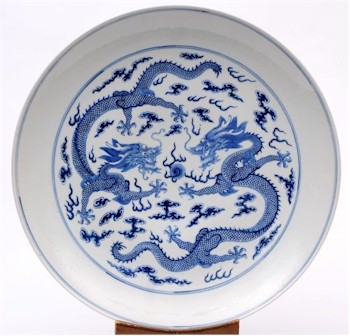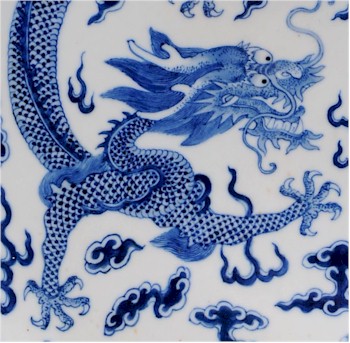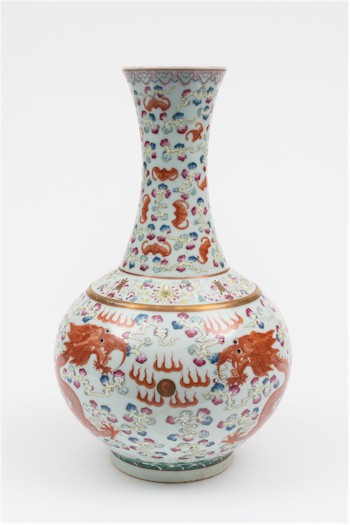
A pair of dragons amongst clouds competing for a pearl.
To most western eyes dragons are vulgar reptilian foes, an enemy to any Christian
man, particularly one with a strong heart and an equally strong sword. The Latin
word Draco is interchangeable meaning either dragon or snake, both symbolic
in western art as the triumph of good over evil. So you have to question, outside
of the Christian narrative, why the dragon, a creature with such a bad track
record, is such a popular motif on Chinese porcelain. Well the answer is simply
that our Oriental brethren perceive this mythical beast not as an ogre, but in a
surprisingly more auspicious and benevolent light.
A powerful creature, that forms part of the Chinese zodiac, it is also the guardian
of the East, the cosmic source of the sun, it is primarily a creature of the water.
I say creature, but it comes not from the animal kingdom although formed from an
identikit of primarily mammalian body parts having the 'head of a camel with horns
of deer, ears of an ox, eyes of a hare with bushy eyebrows, a formidable beard with
long streaming bristles and the body of a serpent with scales of a fish, a formidable
beard with streaming bristles from the mouth to the tail'. Its primary function
in an agrarian society (which China was and arguably still is) was to bring rain,
plunging into the water in autumn and remaining there until spring when it ascended
into the sky to bring rain to the earth and with it fertility, vigour and the opportunity
of prosperity and happiness.

The dragon, how friendly do you think he is?
The closest the dragon comes to violence is in its role as protector. The Buddhists
who arrived in China during the first and second century bought with them the notion
of the dragon as a guardian, both of the religion, but also particularly, bearing
in mind its supernatural powers, as a tomb guardian that would watch over and protect
the souls of the deceased. Certainly from the Tang Dynasty (618-906) onwards it
was a popular motif on all manner of grave goods buried with the deceased and
bearing in mind its rather ferocious appearance presumably all it had to do was
hang around tombs to undertake this task effectively.
The dragon is perhaps more often depicted chasing a flaming disc or pearl, the former
is symbolic of the sun, the latter is seen in Buddhist iconography as the wish granting
jewel symbolic of transcendental wisdom. Whether the dragon's association with the
sun and the rain shows it as a benevolent bringer of fertility and prosperity, or
as a supernaturally wise beast, or that of a powerful guardian of ones ancestors,
when seen as a whole there is little wonder that it was also hijacked as an emblem
of Imperial power. The use of the dragon as an Imperial emblem came with the first
emperor of the Han Dynasty, Han Gaozu, who perpetuated the myth that his mother
was impregnated by a dragon, to legitimise the fact that he came from peasant stock
– a neat and successful spot of propaganda that lasted for nearly 2,000 years until
the fall of the last of Qing emperors in 1911. It all sounds entirely plausible
to me and benevolent or not, I'm not about to start an argument with a dragon.

An upcoming lot in our Autumn 2014 Fine Sale - a
Chinese porcelain vase with a dragon motif
(FS24/410).
- Bearnes Hampton & Littlewood
- Chinese Porcelain
The Dragon, friend or foe? was written on Tuesday, 29th September 2014.







